Excavations, 1923-1933
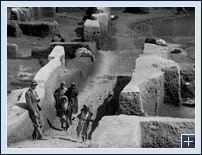 [/kish/fieldmus/images/EX3-large.jpg]
[/kish/fieldmus/images/EX3-large.jpg]
This photograph shows the massive depth and breadth of the excavations in the Y sounding on Ingharra. The field director, Charles Watlin, and workmen are visible in the foreground.
Kish East, Ingharra, Y Sounding. 1928-1929 Season. Negative 67093
In 1921, Stephen Langdon of Oxford University wrote to Berthold Laufer, then Chief Curator of the Anthropology Department of The Field Museum, to propose a joint Mesopotamian expedition. Laufer expressed The Field Museum's interest, and in 1921-22 the expedition's eventual chief financier, Mr. H. Weld-Blundell, conducted a survey of important sites in Mesopotamia, settling on Kish as the site holding the most interest and archaeological potential. In March of 1923, Mr. Ernest Mackay, protégé of the famed archaeologist Sir Flinders Petrie, began the first season of excavations of the Joint Oxford-Field Museum expedition to Kish. Excavations continued during the winter months of the next ten years, from 1923-33, under the absentee direction of Stephen Langdon who, although serving as the director of the project, visited the excavations only twice, in 1924 and 1926. Mackay served as field director through the 1925-26 season, after which Mr. Louis Charles Watelin became field director. Watelin served as field director for the remainder of the project.
During the course of the ten years of excavation, work was conducted on seventeen different mounds both inside and outside the ancient boundaries of Kish. As was the custom of the day, the excavations were absolutely enormous in scale. Both Mackay and Watelin employed hundreds of local men and boys who worked at a break-neck pace to remove soil to depths of fifteen or more meters in trenches tens of meters on a side.
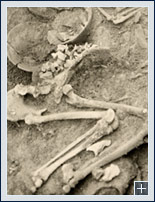 [/kish/fieldmus/images/EX1-large.jpg]
[/kish/fieldmus/images/EX1-large.jpg]
This mid-third millenium B.C. burial, identified as that of an adult female, contained a cylinder seal, a copper pin with a head in the shape of a fish, a copper mirror, 5 stone bowls, and several cosmetic shells.
Kish East, Ingharra, Y Sounding, Burial Y685. February 16, 1931. Oxford Negative 130A
Initial excavations at Kish centered on the ziggurat and adjacent structures at Uhaimir. These represented a series of temple buildings and re-buildings that ranged in date from the Old Babylonian to the Neo-Babylonian period (ca. 1750-550 B.C.), with possible traces of earlier remains of the third millennium B.C. Later work on Ingharra revealed a massive Neo-Babylonian temple complex, roughly 130 meters square, with walls preserved to a height of over 4m. This temple stood upon an Early Dynastic plano-convex brick platform that also supported two adjoining "ziggurats" or temple towers of the mid-third millennium B.C. Broad areas adjacent to the Neo-Babylonian temple were cleared down to plain level in a series of trenches, designated by a veritable alphabet soup of letters, over the course of the excavations. This work revealed habitation levels stretching back to the beginning of the third millennium B.C. as well as a cemetery that extended south toward Mound A. Included in this cemetery were a series of remarkably rich burials, each of which contained multiple human skeletons and a wheeled vehicle drawn by a team of bovids or equids. These are often referred to as "chariots," and the burials as "chariot burials," although the term "cart" more aptly describes these four-wheeled means of conveyance. These graves appear to date to Early Dynastic II (ca. 2700-2600 B.C.) and are the direct predecessors of the richer royal tombs at Ur.
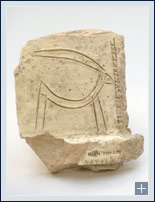 [/kish/fieldmus/images/EX2-large.jpg]
[/kish/fieldmus/images/EX2-large.jpg]
This sherd comes from an elaborate stand probably designed to support a bowl. One piece of that stand is now in each of the three collections into which the Kish material was divided.
Kish East, Mound A, Eastern Slope, Surface. Baked clay. Early Dynastic Period. Ashmolean Museum 1924.235
Mound A contained a palace of the Third Early Dynastic period (ca. 2500 B.C.) over which was another extensive cemetery. The 154 graves in the "A Cemetery" were rich in ceramic vessels; copper weapons, tools, pins, and vessels; and luxury items such as ostrich-egg-shell vessels and, in one case, an iron dagger. They date to the end of the Early Dynastic and beginning of the Akkadian period (the end of the third millennium B.C.). Graves of the same date found on the adjacent portion of Ingharra appear to have been even more richly furnished, attesting to a stratified society in which wealthier individuals were buried closer to the sacred complex with its ziggurats than were the less well-to-do.
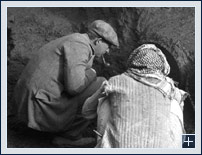 [/kish/fieldmus/images/EX4-large.jpg]
[/kish/fieldmus/images/EX4-large.jpg]
The wheels of the chariots buried at Kish had been compressed by the weight of the soil, which made them appear to be oval. The wood of the wheels had almost completely disintegrated, but their shape and appearance (and the copper nails that studded their rims) were recovered by encasing them in plaster to be shipped to Chicago for conservation and reconstruction. A photograph of the wheels as they appear today can be seen in the Object Gallery.
Kish East, Ingharra, Y Sounding, Chariot Burial. 1927-28 Season. Negative 59632
North of Ingharra was a second, somewhat earlier, Early Dynastic palace, dubbed the "Plano-Convex Building" after the shape of the bricks used in its construction. Mound W, to the west of Ingharra, yielded hundreds of texts of the Neo-Assyrian and Neo-Babylonian periods (first half of the first millennium B.C.) as well as graves of the 5-4th centuries B.C. Tell H, to the east, seems to have been a city of the Sasanian period, including a series of eight "palaces" or elite residences. These were richly decorated with elaborate patterned and figural stucco, datable to the later 6th century A.D. The expedition also excavated in a number of other locations deemed to be of interest by sponsors and/or field directors, including Jamdat Nasr (type site of the eponymous 4th millennium B.C. period), located 30 kilometers northeast of Kish. Here a monumental building, probably administrative in nature, yielded early clay tablets, seal impressions, and richly polychromed pottery vessels.
At the end of each season, pursuant to guidelines established before the first season in 1923, the retained objects were divided, with the Iraq Museum retaining half of the objects and any one-of-a-kind pieces, and the two excavating institutions splitting up the remainder of the objects, with Oxford retaining all inscribed objects, and The Field Museum of Natural History receiving all archaeological, skeletal, and scientific materials. Similarly, the records of the excavation were dispersed to the three institutions. Duplicate sets of the field registers, cards, and photographs went to the Ashmolean and the Field Museum. Records such as the field directors' reports to Langdon eventually ended up in Chicago, while Mackay's detailed notes on his discoveries are part of the Ashmolean Museum archives. While this was standard operating procedure for the time, note-keeping at this project was, as with many other elements of the excavation, sub par. The results of the project was thus a single coherent assemblage of material culture arbitrarily divided into three collections separated by thousands of miles. This division occurred not just on the scale of individual contexts (e.g., graves or rooms), but also on the level of individual artifacts, pieces of which were dispatched to the four corners of the globe without note of their common origin.
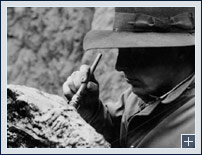 [/kish/fieldmus/images/EX5-large.jpg]
[/kish/fieldmus/images/EX5-large.jpg]
Organic materials are poorly preserved in the soils of Iraq, which have a high salt content. In order to be taken from the earth, fragile bones need to be consolidated so that they do not fragment into tiny pieces. At the time of the Kish Expedition, the most satisfactory way to accomplish this was to paint them heavily with melted wax, which hardened and then could be lifted from the ground.
Kish East, Ingharra, Y Sounding, Chariot Burial 2. 1927-28 Season. Negative Unknown #4
The Field Museum
The Field Museum, 'Excavations, 1923-1933', The Field Museum's Kish Database Project, 2004-09, The Field Museum, 2025 [http://oracc.org/kish/fieldmus/KishPast,PresentandFuture/Excavations,1923-1933/]